Advancing Collaborative Water Governance: Unravelling Stakeholders’ Relationships and Influences in Contentious River Basins
Abstract
1. Introduction
2. Case study: Rapel River Basin
3. Methods
3.1. Stakeholder Analysis and Participatory Process
3.2. Shared Vision
3.3. Social Network Analysis
4. Results
4.1. Stakeholder Analysis and Interest-Influence Map
4.2. Shared Vision
4.3. Social Network Analysis
4.3.1. Relationships between Stakeholders: Collaboration Ties, Information Flows, and Financial Exchanges Networks
4.3.2. Stakeholder-Based Centrality Metrics
4.3.3. Interest-Influence Map Versus Stakeholder-Based Centrality Metrics
4.3.4. Stakeholders’ Influence on the Elements of The Vision
5. Discussion
5.1. Stakeholder Participation, Interests and Collaborative Process
5.2. Network-Based Metrics and Implications for CWG
5.3. Stakeholders’ Roles and Influence on the Shared Vision for the RRB
5.4. Advancing Collaborative Water Governance and Addressing Implementation Challenges
6. Conclusions
Author Contributions
Funding
Acknowledgments
Conflicts of Interest
References
- Basco-Carrera, L.; van Beek, E.; Jonoski, A.; Benítez-Ávila, C.; Guntoro, F.P. Collaborative Modelling for Informed Decision Making and Inclusive Water Development. Water Resour. Manag. 2017, 31, 2611–2625. [Google Scholar] [CrossRef]
- Bouwer, H. Integrated water management: Emerging issues and challenges. Agric. Water Manag. 2000, 45, 217–228. [Google Scholar] [CrossRef]
- United Nations—Water. Coping with water scarcity. A strategic issue and priority for system-wide action. In UN-Water Thematic Initiatives; Technical Report; United Nations: New York, NY, USA, 2006. [Google Scholar]
- World Economic Forum. Global Risks 2019: Insight Report, 14th ed.; World Economic Forum: Geneva, Switzerland, 2019. [Google Scholar]
- GWP. Integrated Water Resources Management; Global Water Partnership: Stockholm, Sweden, 2000. [Google Scholar]
- OECD. Water Governance in OECD Countries: A Multi-Level Approach, OECD Studies on Water, ed.; OECD: Paris, France, 2011. [Google Scholar]
- Lautze, J.; de Silva, S.; Giordano, M.; Sanford, L. Putting the cart before the horse: Water governance and IWRM. Nat. Resour. Forum 2011, 35, 1–8. [Google Scholar] [CrossRef]
- Jiménez, A.; Saikia, P.; Giné, R.; Avello, P.; Leten, J.; Lymer, B.L.; Schneider, K.; Ward, R. Unpacking Water Governance: A Framework for Practitioners. Water 2020, 12, 827. [Google Scholar] [CrossRef]
- OECD. OECD Principles on Water Governance; Technical Report; OECD: Paris, France, 2015. [Google Scholar]
- Pahl-Wostl, C. An Evolutionary Perspective on Water Governance: From Understanding to Transformation. Water Resour. Manag. 2017, 31, 2917–2932. [Google Scholar] [CrossRef]
- Cook, C.; Bakker, K. Water security: Debating an emerging paradigm. Glob. Environ. Chang. 2012, 22, 94–102. [Google Scholar] [CrossRef]
- Zwarteveen, M.; Kemerink-Seyoum, J.S.; Kooy, M.; Evers, J.; Guerrero, T.A.; Batubara, B.; Biza, A.; Boakye-Ansah, A.; Faber, S.; Flamini, A.C.; et al. Engaging with the politics of water governance. Wiley Interdiscip. Rev. Water 2017, 4, e1245. [Google Scholar] [CrossRef]
- Ansell, C.; Gash, A. Collaborative Governance in Theory and Practice. J. Public Adm. Res. Theory 2008, 18, 543–571. [Google Scholar] [CrossRef]
- Emerson, K.; Nabatchi, T.; Balogh, S. An Integrative Framework for Collaborative Governance. J. Public Adm. Res. Theory 2012, 22, 1–29. [Google Scholar] [CrossRef]
- Holley, C. Crafting Collaborative Governance: Water Resources, California’s Delta Plan, and Audited Self-Management in New Zealand. Environ. Law Rep. News Anal. 2015, 45, 1–14. [Google Scholar]
- Harrington, C. The political ontology of collaborative water governance. Water Int. 2017, 42, 254–270. [Google Scholar] [CrossRef]
- Marín, A.; Berkes, F. Network approach for understanding small-scale fisheries governance: The case of the Chilean coastal co-management system. Mar. Policy 2010, 34, 851–858. [Google Scholar] [CrossRef]
- Connick, S.; Innes, J.E. Outcomes of Collaborative Water Policy Making: Applying Complexity Thinking to Evaluation. J. Environ. Plan. Manag. 2003, 46, 177–197. [Google Scholar] [CrossRef]
- Sabatier, P.; Focht, W.; Lubell, M.; Trachtenberg, Z.; Vedlitz, A.; Matlock, M. Swimming Upstream: Collaborative Approaches to Watershed Management; MIT PR: Cambridge, MA, USA, 2005. [Google Scholar]
- Butterworth, J.; Warner, J.; Moriarty, P.; Smits, S.; Batchelor, C. Finding practical approaches to integrated water resources management. Water Altern. 2010, 3, 68–81. [Google Scholar]
- Moriarty, P.; Batchelor, C.; Laban, P.; Fahmy, H. Developing a practical approach to ‘light IWRM’ in the middle east. Water Altern. 2010, 3, 122–136. [Google Scholar]
- Smith, J.L. A critical appreciation of the “bottom-up” approach to sustainable water management: Embracing complexity rather than desirability. Local Environ. 2008, 13, 353–366. [Google Scholar] [CrossRef]
- Agrawal, A.; Gibson, C.C. Enchantment and Disenchantment: The Role of Community in Natural Resource Conservation. World Dev. 1999, 27, 629–649. [Google Scholar] [CrossRef]
- Ogada, J.O.; Krhoda, G.O.; Veen, A.V.D.; Marani, M.; van Oel, P.R. Managing resources through stakeholder networks: Collaborative water governance for Lake Naivasha basin, Kenya. Water Int. 2017, 42, 271–290. [Google Scholar] [CrossRef]
- Ananda, J.; Proctor, W. Collaborative approaches to water management and planning: An institutional perspective. Ecol. Econ. 2013, 86, 97–106. [Google Scholar] [CrossRef]
- Holley, C.; Sinclair, D. Deliberative participation, environmental law and collaborative governance: Insights from surface and groundwater studies. Environ. Plan. Law J. 2013, 30, 32–55. [Google Scholar]
- Chaffin, B.; Garmestani, A.; Gosnell, H.; Craig, R. Institutional networks and adaptive water governance in the Klamath River Basin, USA. Environ. Sci. Policy 2016, 57, 112–121. [Google Scholar] [CrossRef]
- Fliervoet, J.M.; van den Born, R.J.; Meijerink, S.V. A stakeholder’s evaluation of collaborative processes for maintaining multi-functional floodplains: A Dutch case study. Int. J. River Basin Manag. 2017, 15, 175–186. [Google Scholar] [CrossRef]
- Stringer, L.C.; Reed, M.S.; Fleskens, L.; Thomas, R.J.; Le, Q.B.; Lala-Pritchard, T. A New Dryland Development Paradigm Grounded in Empirical Analysis of Dryland Systems Science. Land Degrad. Dev. 2017, 28, 1952–1961. [Google Scholar] [CrossRef]
- Bodin, O.; Crona, B. The role of social networks in natural resource governance: What relational patterns make a difference? Glob. Environ. Chang. 2009, 19, 366–374. [Google Scholar] [CrossRef]
- Prell, C.; Hubacek, K.; Reed, M. Stakeholder Analysis and Social Network Analysis in Natural Resource Management. Soc. Nat. Resour. 2009, 22, 501–518. [Google Scholar] [CrossRef]
- Prell, C.; Reed, M.; Racin, L.; Hubacek, K. Competing structure, competing views: The role of formal and informal structures in shaping stakeholder perceptions. Ecol. Soc. 2010, 15, 34. [Google Scholar] [CrossRef]
- Stein, C.; Ernstson, H.; Barron, J. A social network approach to analyzing water governance: The case of the Mkindo catchment, Tanzania. Phys. Chem. Earth Parts A/B/C 2011, 36, 1085–1092. [Google Scholar] [CrossRef]
- Larson, S.; Alexander, K.S.; Djalante, R.; Kirono, D.G.C. The Added Value of Understanding Informal Social Networks in an Adaptive Capacity Assessment: Explorations of an Urban Water Management System in Indonesia. Water Resour. Manag. 2013, 27, 4425–4441. [Google Scholar] [CrossRef]
- Fliervoet, J.M.; Geerling, G.W.; Mostert, E.; Smits, A.J.M. Analyzing Collaborative Governance Through Social Network Analysis: A Case Study of River Management Along the Waal River in The Netherlands. Environ. Manag. 2016, 57, 355–367. [Google Scholar] [CrossRef]
- Crona, B.; Bodin, O. What You Know is Who You Know? Communication Patterns Among Resource Users as a Prerequisite for Co-management. Ecol. Soc. 2006, 11, 7. [Google Scholar] [CrossRef]
- Gálvez, V.; Rojas, R.; Bennison, G.; Prats, C.; Claro, E. Collaborate or perish: Water resources management under contentious water use in a semiarid basin. Int. J. River Basin Manag. 2019. [Google Scholar] [CrossRef]
- Cardwell, H.; Langsdale, S.; Stephenson, K. The Shared Vision Planning Primer: How to Incorporate Computer Aided Dispute Resolution in Water Resources Planning; Institute Water Resources, US Army Corps of Engineers: Washington, DC, USA, 2009. [Google Scholar]
- Bourget, L. Converging Waters: Integrating Collaborative Modeling with Participatory Processes to Make Water Resources Decisions; IWR Press: Alexandria, VA, USA, 2011. [Google Scholar]
- Reed, M.S.; Graves, A.; Dandy, N.; Posthumus, H.; Hubacek, K.; Morris, J.; Prell, C.; Quinn, C.H.; Stringer, L.C. Who’s in and why? A typology of stakeholder analysis methods for natural resource management. J. Environ. Manag. 2009, 90, 1933–1949. [Google Scholar] [CrossRef] [PubMed]
- Wasserman, S.; Faust, K. Social Network Analysis: Methods and Applications; Cambridge University Press: Cambridge, UK, 1994. [Google Scholar]
- Dimadama, Z.; Zikos, D. Social Networks as Trojan Horses to Challenge the Dominance of Existing Hierarchies: Knowledge and Learning in the Water Governance of Volos, Greece. Water Resour. Manag. 2010, 24, 3853–3870. [Google Scholar] [CrossRef]
- Lienert, J.; Schnetzer, F.; Ingold, K. Stakeholder analysis combined with social network analysis provides fine-grained insights into water infrastructure planning processes. J. Environ. Manag. 2013, 125, 134–148. [Google Scholar] [CrossRef] [PubMed]
- Krupa, M.; Cenek, M.; Powell, J.; Trammell, E.J. Mapping the Stakeholders: Using Social Network Analysis to Increase the Legitimacy and Transparency of Participatory Scenario Planning. Soc. Nat. Resour. 2018, 31, 136–141. [Google Scholar] [CrossRef]
- World Bank. Chile: Diagnóstico de la Gestión de los Recursos Hídricos; Technical Report; World Bank: Washington, DC, USA, 2011. [Google Scholar]
- Retamal, M.R.; Andreoli, A.; Arumi, J.L.; Rojas, J.; Parra, O. Gobernanza del Agua y Cambio Climático: Fortalezas y Debilidades del Actual Sistema de Gestión del Agua en Chile. Análisis Interno. Interciencia 2013, 38, 8–16. [Google Scholar]
- Hurlbert, M.A.; Diaz, H. Water Governance in Chile and Canada: A Comparison of Adaptive Characteristics. Ecol. Soc. 2013, 18. [Google Scholar] [CrossRef]
- Hill, M. Climate Change and Water Governance; Springer: Cham, The Netherlands, 2013. [Google Scholar]
- UN Environment. Progress on Integrated Water Resources Management. Global Baseline for SDG 6 Indicator 6.5.1: Degree of IWRM Implementation; UN Environment: Nairobi, Kenya, 2018. [Google Scholar]
- Dourojeanni, A.; Chevaleraud, Y.; Acevedo Alvarez, P. Las Mesas del Agua y la Gestion de Cuencas en Chile. Estudio de Caso, Region de Atacama, Chile; Technical Report; Centro Atacama—Agua y Energía: Copiapó, Chile, 2010. [Google Scholar]
- DGA. Atlas del Agua Chile 2016; Ministerio de Obras Públicas: Santiago, Chile, 2016; Chapter 4. [Google Scholar]
- Fundación Chile. Reporte Huella hídrica en Chile. Sectores Prioritarios de la Cuenca del río Rapel; Technical Report; Fundación Chile: Santiago, Chile, 2015. [Google Scholar]
- DGA. Información Pluviométrica, Fluviométrica, Estado de Embalses y Aguas Subterráneas; Technical Report 488; Dirección General de Aguas: Santiago, Chile, 2018. [Google Scholar]
- Rojas, M.; Aldunce, P.; Farías, L.; González, H.; Marquet, P.; Muñoz, J.; Palma-Behnke, R.; Stehr, A.; Vicuña, S. Evidencia Científica y Cambio Climático en Chile: Resumen para Tomadores de Decisiones; Technical Report; Comité Científico COP25; Ministerio de Ciencia, Tecnología, Conocimiento e Innovación: Santiago, Chile, 2019. [Google Scholar]
- Davis, M.D. Integrated Water Resource Management in Chile: To Be or Not To Be. In Critical Transitions in Water and Environmental Resources Management; American Society of Civil Engineers: Reston, VA, USA, 2004. [Google Scholar]
- Bitran, E.; Rivera, P.; Villena, M.J. Water management problems in the Copiapó Basin, Chile: Markets, severe scarcity and the regulator. Water Policy 2014, 16, 844–863. [Google Scholar] [CrossRef]
- Prieto, M. Bringing water markets down to Chile’s Atacama Desert. Water Int. 2016, 41, 191–212. [Google Scholar] [CrossRef]
- Budds, J. Securing the market: Water security and the internal contradictions of Chile’s Water Code. Geoforum 2018. [Google Scholar] [CrossRef]
- Bauer, C.J. Against the Current: Privatization, Water Markets, and the State in Chile; Springer: New York, NY, USA, 1998. [Google Scholar]
- Bauer, C.J. In the image of the market: The Chilean model of water resources management. Int. J. Water 2005, 3, 146–165. [Google Scholar] [CrossRef]
- Bauer, C.J. Water conflicts and entrenched governance problems in Chile’s market model. Water Altern. 2015, 8, 147–172. [Google Scholar]
- Donoso, G. Overall Assessment of Chile’s Water Policy and Its Challenges. In Water Policy in Chile; Springer International Publishing: Berlin/Heidelberg, Germany, 2018; pp. 209–219. [Google Scholar]
- Basco-Carrera, L.; Warren, A.; van Beek, E.; Jonoski, A.; Giardino, A. Collaborative modelling or participatory modelling? A framework for water resources management. Environ. Model. Softw. 2017, 91, 95–110. [Google Scholar] [CrossRef]
- Basco-Carrera, L.; Meijers, E.; Sarısoy, H.D.; Şanli, N.O.; Coşkun, S.; Oliemans, W.; van Beek, E.; Karaaslan, Y.; Jonoski, A. An adapted companion modelling approach for enhancing multi-stakeholder cooperation in complex river basins. Int. J. Sustain. Dev. World Ecol. 2018, 25, 747–764. [Google Scholar] [CrossRef]
- Langsdale, S.; Beall, A.; Bourget, E.; Hagen, E.; Kudlas, S.; Palmer, R.; Tate, D.; Werick, W. Collaborative Modeling for Decision Support in Water Resources: Principles and Best Practices. J. Am. Water Resour. Assoc. 2013, 49, 629–638. [Google Scholar] [CrossRef]
- Schneider, F.; Rist, S. Envisioning sustainable water futures in a transdisciplinary learning process: Combining normative, explorative, and participatory scenario approaches. Sustain. Sci. 2014, 9, 463–481. [Google Scholar] [CrossRef]
- Tennekes, M. Treemap: Treemap Visualization. Technical Report. 2017. Available online: https://cran.r-project.org/web/packages/treemap/treemap.pdf (accessed on 24 November 2020).
- Tabassum, S.; Pereira, F.S.F.; Fernandes, S.; Gama, J. Social network analysis: An overview. WIREs Data Min. Knowl. Discov. 2018, 8. [Google Scholar] [CrossRef]
- Borgatti, S.; Everett, M.; Freeman, L. UCINET for Windows: Software for Social Network Analysis; Technical Report; Analytic Technologies: Harvard, MA, USA, 2002. [Google Scholar]
- Borgatti, S.P.; Everett, M.G. Models of core/periphery structures. Soc. Netw. 2000, 21, 375–395. [Google Scholar] [CrossRef]
- Borgatti, S.; Everett, M.; Johnson, J. Analysing Social Networks, 2nd ed.; SAGE: Los Angeles, CA, USA, 2018. [Google Scholar]
- Mostert, E.; Craps, M.; Pahl-Wostl, C. Social learning: The key to integrated water resources management? Water Int. 2008, 33, 293–304. [Google Scholar] [CrossRef]
- Reed, M.; Evely, A.; Cundill, G.; Fazey, I.; Glass, J.; Laing, A.; Newig, J.; Parrish, B.; Prell, C.; Raymond, C.; et al. What is social learning? Ecol. Soc. 2010, 15, 1–10. [Google Scholar] [CrossRef]
- Sayles, J.S.; Baggio, J.A. Who collaborates and why: Assessment and diagnostic of governance network integration for salmon restoration in Puget Sound, USA. J. Environ. Manag. 2017, 186, 64–78. [Google Scholar] [CrossRef] [PubMed]
- Megdal, S.; Eden, S.; Shamir, E. Water Governance, Stakeholder Engagement, and Sustainable Water Resources Management. Water 2017, 9, 190. [Google Scholar] [CrossRef]
- Bodin, O.; Crona, B.; Ernstson, H. Social Networks in Natural Resource Management: What Is There to Learn from a Structural Perspective? Ecol. Soc. 2006, 11, 1–8. [Google Scholar] [CrossRef]
- Vignola, R.; McDaniels, T.L.; Scholz, R.W. Governance structures for ecosystem-based adaptation: Using policy-network analysis to identify key organizations for bridging information across scales and policy areas. Environ. Sci. Policy 2013, 31, 71–84. [Google Scholar] [CrossRef]
- Sandström, A.; Rova, C. Adaptive Co-management Networks: A Comparative Analysis of Two Fishery Conservation Areas in Sweden. Ecol. Soc. 2010, 15, 1–23. [Google Scholar] [CrossRef]
- Ruzol, C.; Banzon-Cabanilla, D.; Ancog, R.; Peralta, E. Understanding water pollution management: Evidence and insights from incorporating cultural theory in social network analysis. Glob. Environ. Chang. 2017, 45, 183–193. [Google Scholar] [CrossRef]
- dos Muchangos, L.S.; Tokai, A.; Hanashima, A. Stakeholder analysis and social network analysis to evaluate the stakeholders of a MSWM system—A pilot study of Maputo City. Environ. Dev. 2017, 24, 124–135. [Google Scholar] [CrossRef]
- Blanc, S.; Lingua, F.; Bioglio, L.; Pensa, R.; Brun, F.; Mosso, A. Implementing Participatory Processes in Forestry Training Using Social Network Analysis Techniques. Forests 2018, 9, 463. [Google Scholar] [CrossRef]
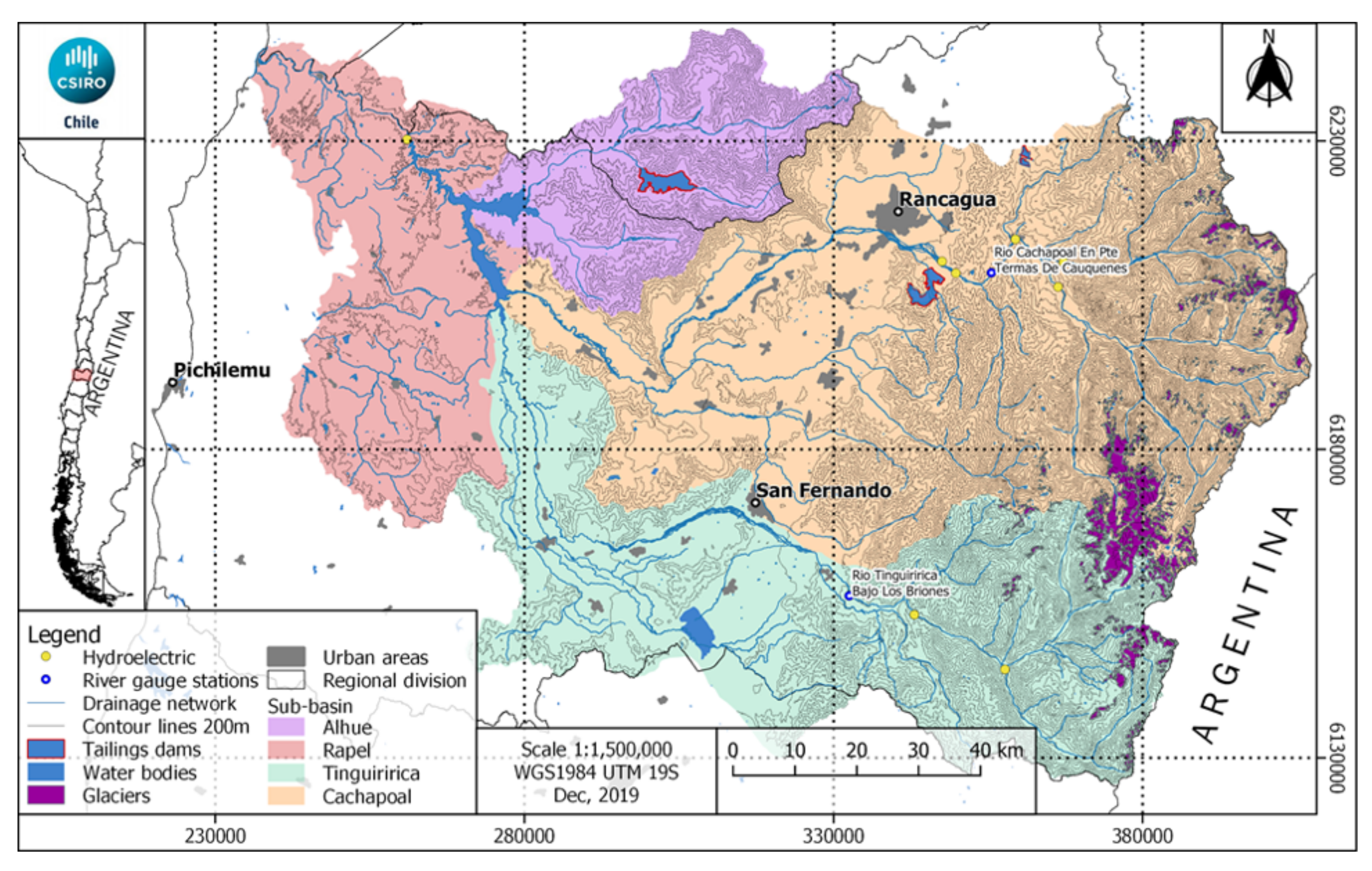

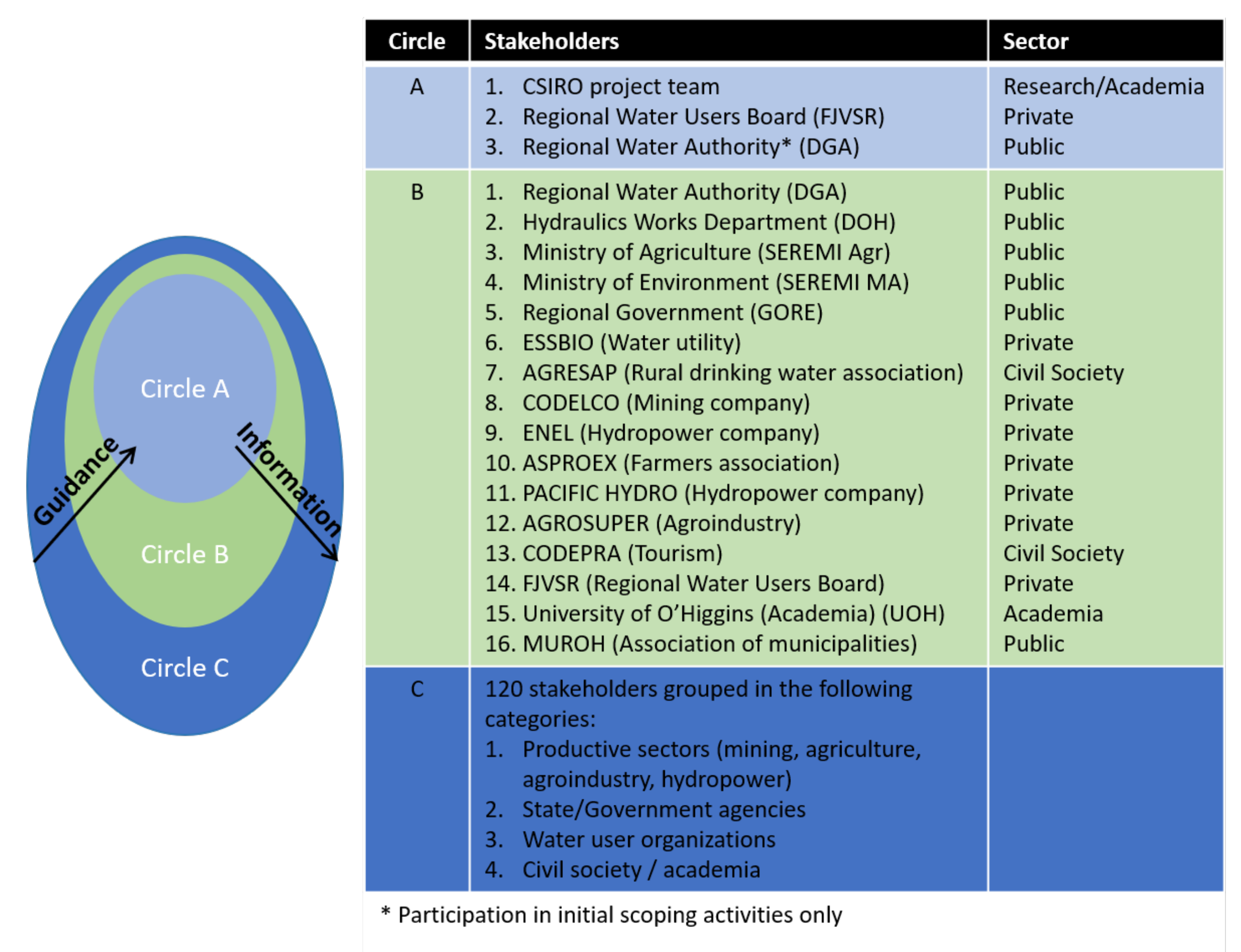
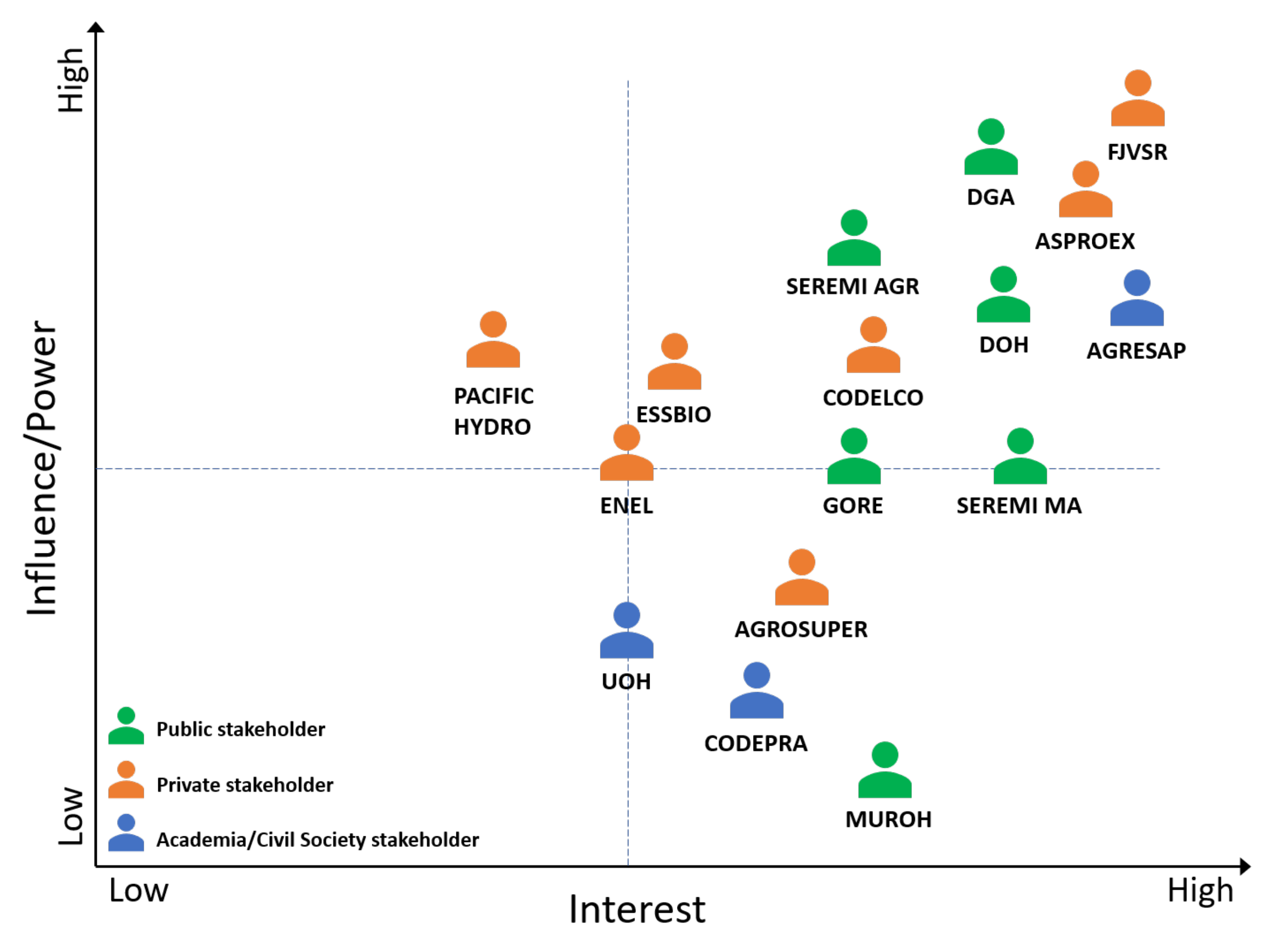
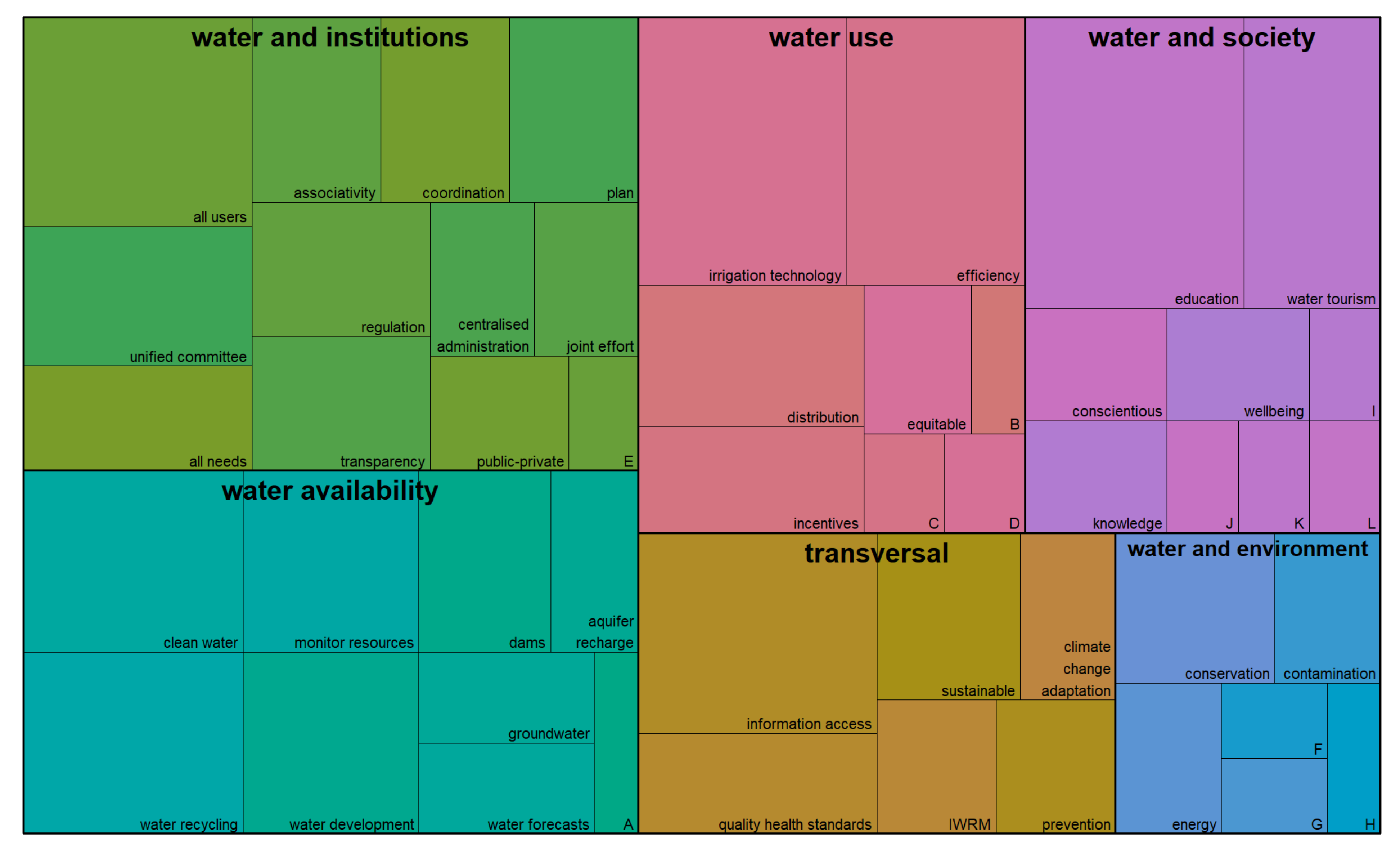
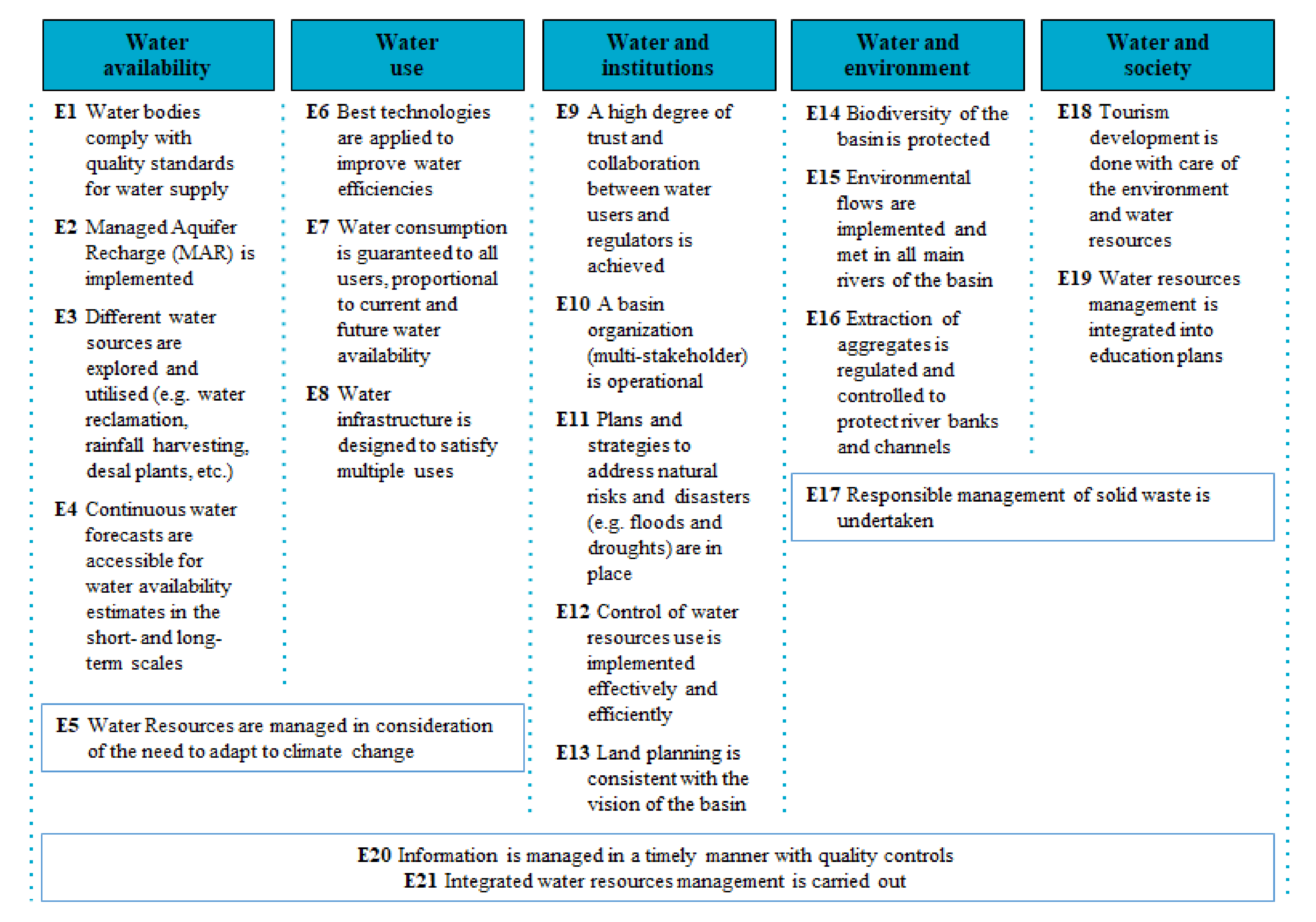
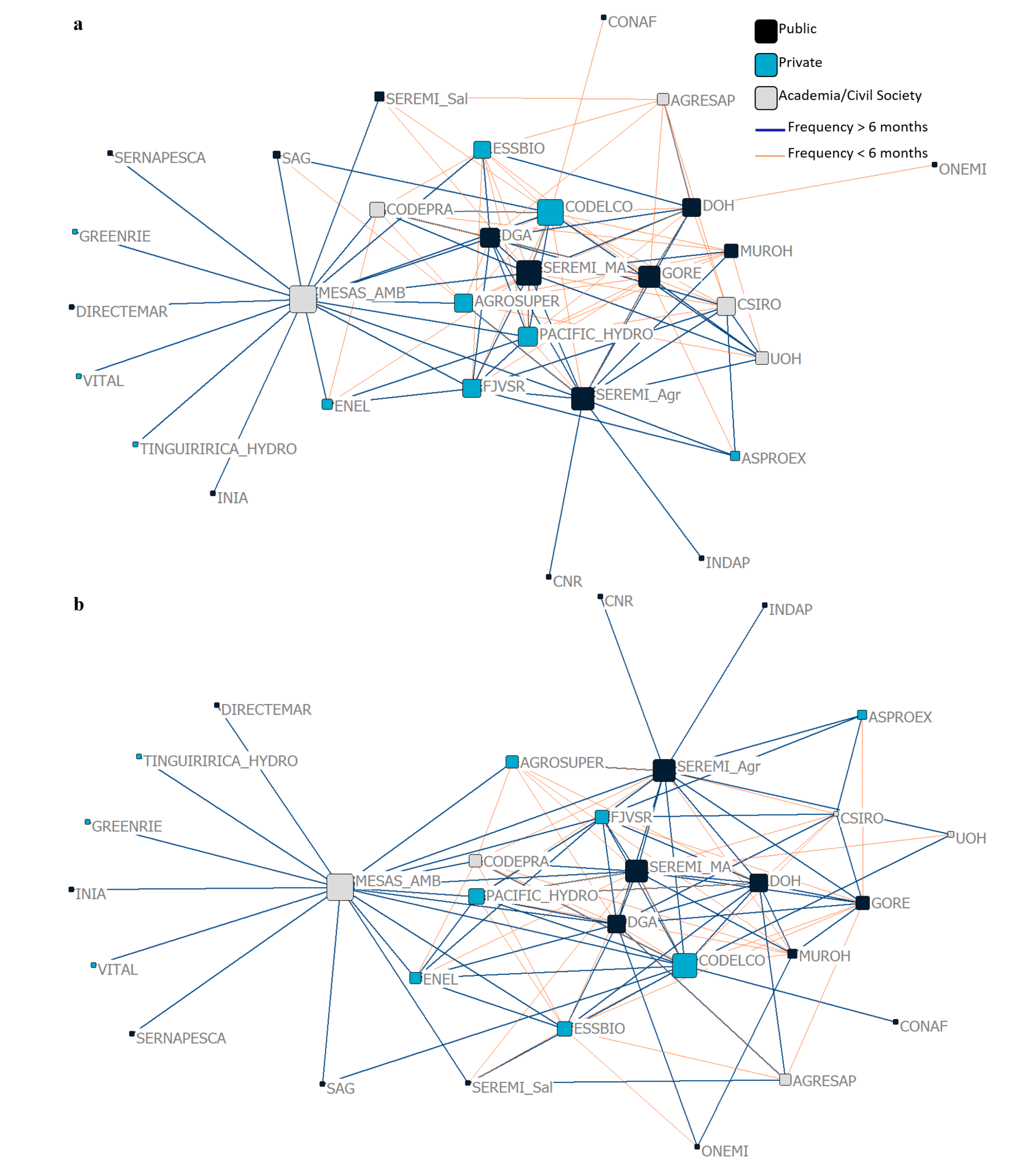
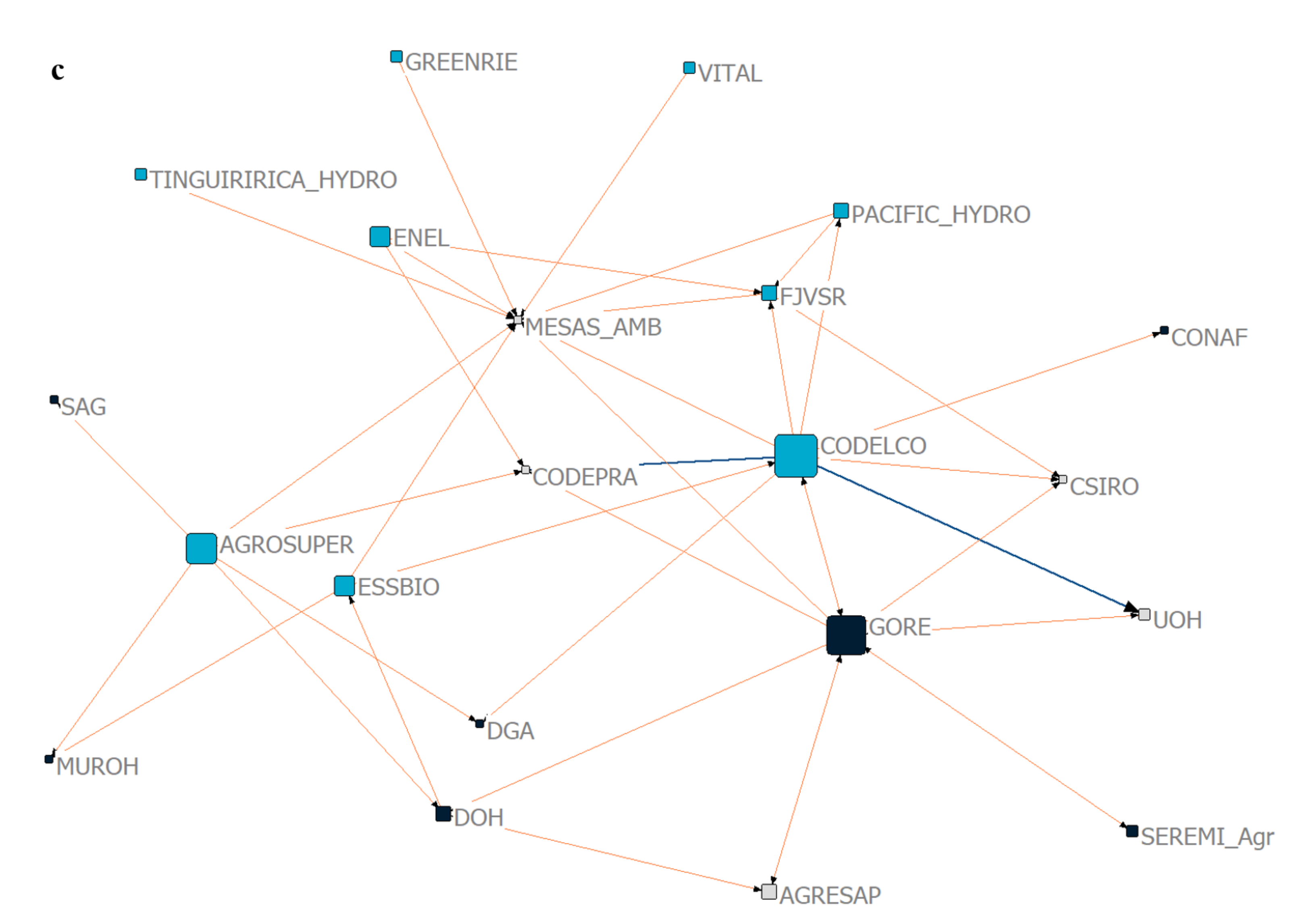
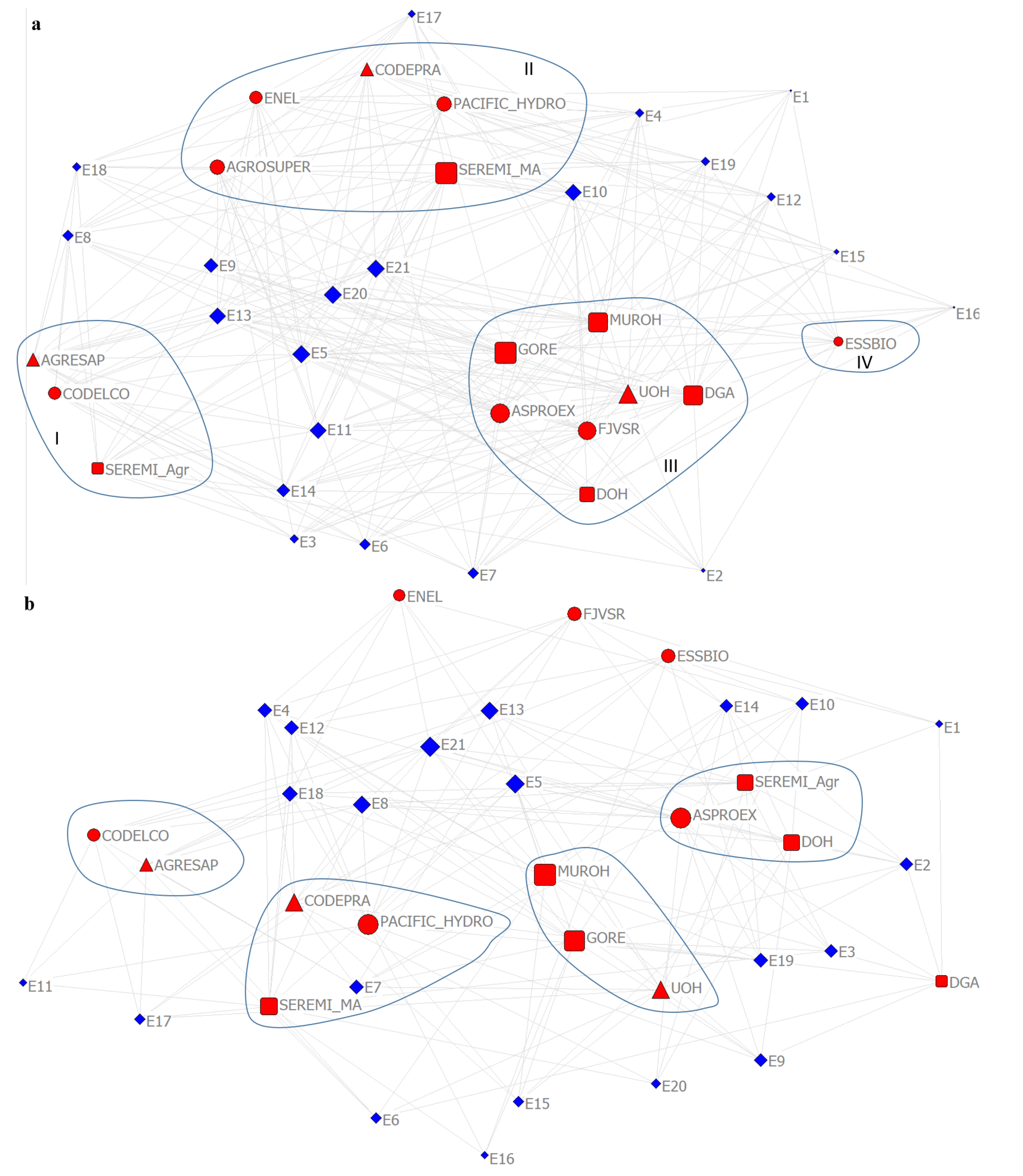
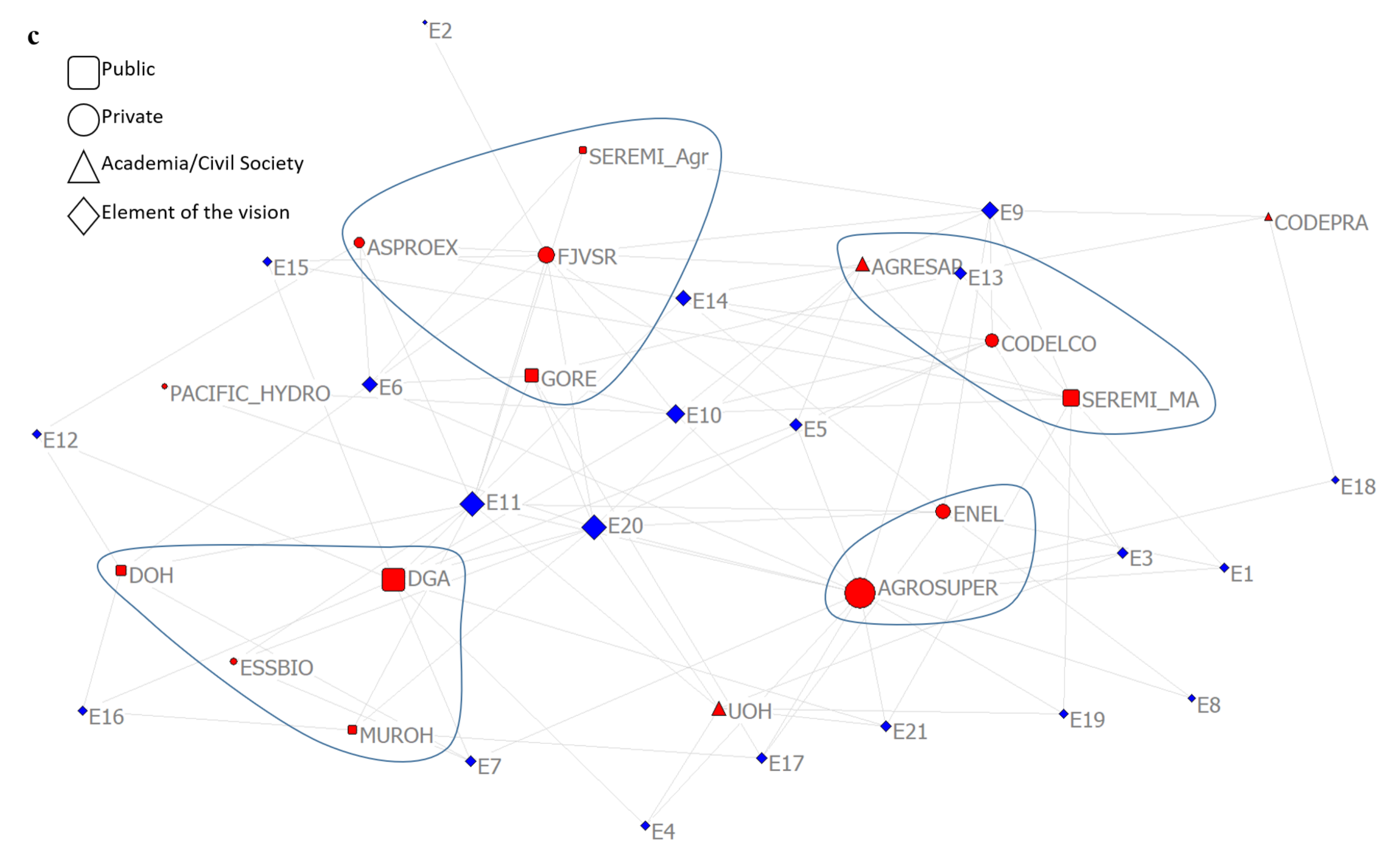
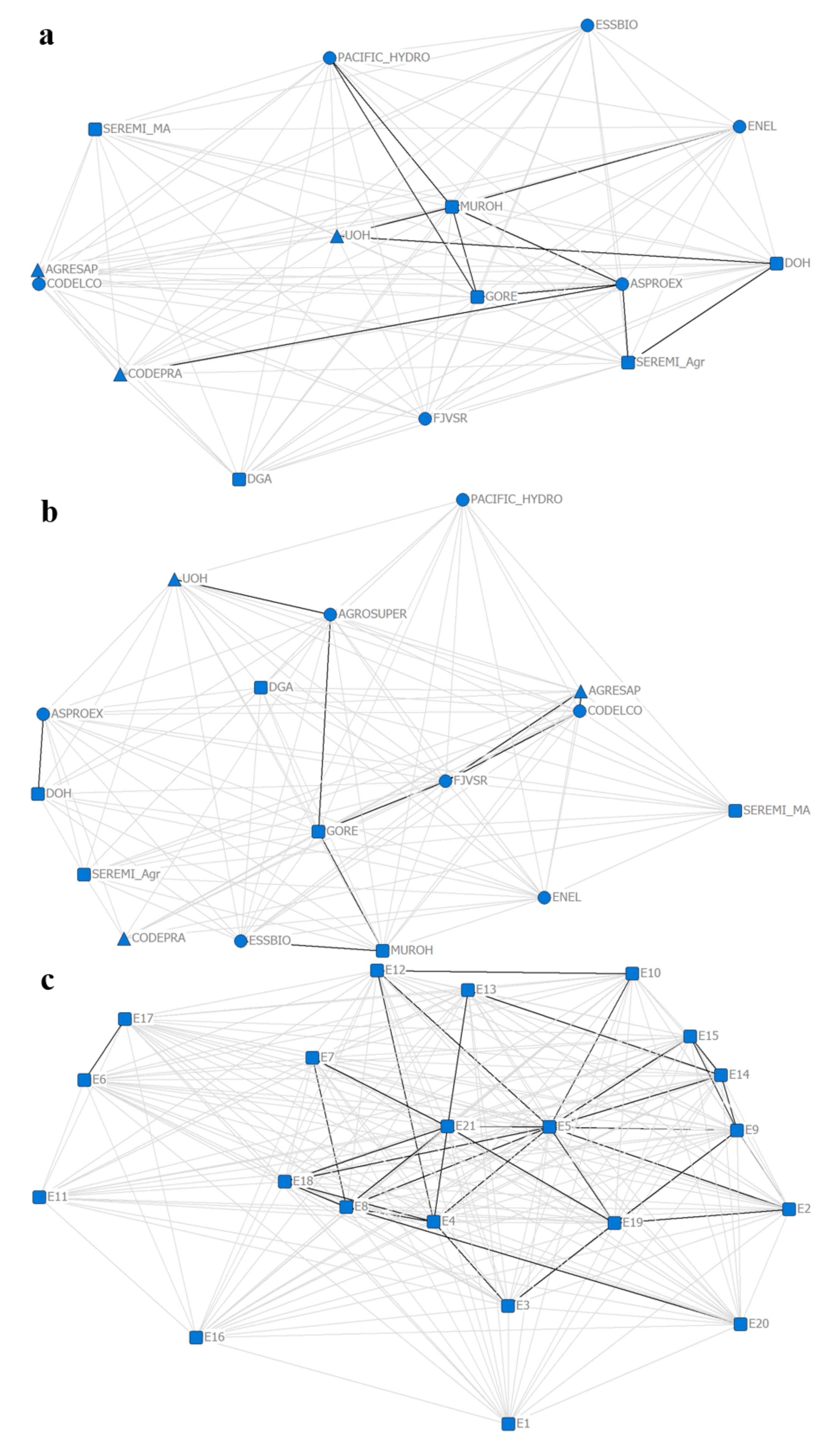

| SNA Metric | Definition |
|---|---|
| Degree Centrality | Number of connections (input and output) that a stakeholder has in the network. Represents the number of connections and therefore connectivity within the corresponding network. |
| Closeness Centrality | Shortest distance between each stakeholder. Greater closeness centrality implies higher proximity and, consequently, a greater capacity to access other stakeholders through the network. |
| Betweenness Centrality | Percentage of the shortest routes between stakeholders passing through a particular stakeholder. Greater betweenness centrality implies greater importance in the control of material flow; that is, the stakeholder is key in the distribution of the material flow (collaboration, information and/or financial resources). |
| Eigenvector Centrality | Weighting of the number of connections due to the relevance of the stakeholders they connect. The stakeholders connected to more influential stakeholders (i.e., better connected) have a greater centrality of their own value. Peripheral stakeholders, therefore, have a lower centrality of their own value. |
| Stakeholder | Collaboration | Information | Financial | |||||||||
|---|---|---|---|---|---|---|---|---|---|---|---|---|
| DCent | CCent | BCent | ECent | DCent | CCent | BCent | ECent | DCent | CCent | BCent | ECent | |
| AGRESAP | 0.207 | 0.345 | 0.005 | 0.120 | 0.172 | 0.392 | 0.002 | 0.106 | 0.069 | 0.266 | 0 | 0.095 |
| AGROSUPER | 0.379 | 0.408 | 0.032 | 0.233 | 0.241 | 0.426 | 0.006 | 0.170 | 0.207 | 0.248 | 0.082 | 0.199 |
| ASPROEX | 0.138 | 0.345 | 0 | 0.094 | 0.138 | 0.387 | 0 | 0.088 | 0 | 0.167 | 0 | 0 |
| CODELCO | 0.586 | 0.460 | 0.133 | 0.322 | 0.586 | 0.518 | 0.148 | 0.319 | 0.345 | 0.322 | 0.124 | 0.446 |
| CODEPRA | 0.310 | 0.372 | 0.011 | 0.198 | 0.310 | 0.439 | 0.008 | 0.211 | 0.138 | 0.299 | 0.022 | 0.219 |
| CSIRO * | 0.379 | 0.200 | 0.017 | 0.234 | 0.276 | 0.250 | 0.004 | 0.190 | 0.103 | 0.167 | 0.002 | 0.209 |
| DGA | 0.414 | 0.397 | 0.027 | 0.264 | 0.517 | 0.475 | 0.066 | 0.308 | 0.069 | 0.167 | 0.005 | 0.122 |
| DOH | 0.379 | 0.377 | 0.076 | 0.232 | 0.414 | 0.475 | 0.017 | 0.263 | 0.138 | 0.261 | 0.021 | 0.170 |
| ENEL | 0.172 | 0.322 | 0.001 | 0.115 | 0.276 | 0.420 | 0.001 | 0.197 | 0.103 | 0.176 | 0.004 | 0.183 |
| ESSBIO | 0.345 | 0.349 | 0.019 | 0.225 | 0.414 | 0.420 | 0.044 | 0.242 | 0.172 | 0.181 | 0.036 | 0.274 |
| FJVSR | 0.379 | 0.382 | 0.029 | 0.240 | 0.379 | 0.433 | 0.029 | 0.249 | 0.207 | 0.172 | 0.018 | 0.331 |
| GORE | 0.483 | 0.392 | 0.036 | 0.282 | 0.379 | 0.446 | 0.022 | 0.235 | 0.276 | 0.290 | 0.110 | 0.333 |
| MESAS AMB * | 0.621 | 0.690 | 0.408 | 0.250 | 0.621 | 0.725 | 0.409 | 0.262 | 0.345 | 0.330 | 0.182 | 0.420 |
| MUROH | 0.276 | 0.354 | 0.003 | 0.187 | 0.310 | 0.392 | 0.016 | 0.194 | 0.069 | 0.167 | 0.002 | 0.089 |
| PACIFIC HYDRO | 0.414 | 0.420 | 0.027 | 0.266 | 0.345 | 0.460 | 0.009 | 0.242 | 0.103 | 0.176 | 0 | 0.226 |
| SAG * | 0.103 | 0.200 | 0 | 0.073 | 0.069 | 0.250 | 0 | 0.053 | 0.034 | 0.167 | 0 | 0.038 |
| SEREMI Agr | 0.517 | 0.433 | 0.177 | 0.283 | 0.552 | 0.500 | 0.192 | 0.292 | 0.034 | 0.246 | 0 | 0.063 |
| SEREMI MA | 0.552 | 0.426 | 0.057 | 0.324 | 0.552 | 0.500 | 0.055 | 0.327 | 0 | 0.167 | 0 | 0 |
| SEREMI Sal * | 0.138 | 0.200 | 0.008 | 0.091 | 0.172 | 0.250 | 0.008 | 0.115 | 0 | 0.167 | 0 | 0 |
| UOH | 0.241 | 0.367 | 0.001 | 0.168 | 0.103 | 0.367 | 0 | 0.086 | 0.069 | 0.246 | 0 | 0.147 |
Publisher’s Note: MDPI stays neutral with regard to jurisdictional claims in published maps and institutional affiliations. |
© 2020 by the authors. Licensee MDPI, Basel, Switzerland. This article is an open access article distributed under the terms and conditions of the Creative Commons Attribution (CC BY) license (http://creativecommons.org/licenses/by/4.0/).
Share and Cite
Rojas, R.; Bennison, G.; Gálvez, V.; Claro, E.; Castelblanco, G. Advancing Collaborative Water Governance: Unravelling Stakeholders’ Relationships and Influences in Contentious River Basins. Water 2020, 12, 3316. https://doi.org/10.3390/w12123316
Rojas R, Bennison G, Gálvez V, Claro E, Castelblanco G. Advancing Collaborative Water Governance: Unravelling Stakeholders’ Relationships and Influences in Contentious River Basins. Water. 2020; 12(12):3316. https://doi.org/10.3390/w12123316
Chicago/Turabian StyleRojas, Rodrigo, Gabriella Bennison, Victor Gálvez, Edmundo Claro, and Gabriel Castelblanco. 2020. "Advancing Collaborative Water Governance: Unravelling Stakeholders’ Relationships and Influences in Contentious River Basins" Water 12, no. 12: 3316. https://doi.org/10.3390/w12123316
APA StyleRojas, R., Bennison, G., Gálvez, V., Claro, E., & Castelblanco, G. (2020). Advancing Collaborative Water Governance: Unravelling Stakeholders’ Relationships and Influences in Contentious River Basins. Water, 12(12), 3316. https://doi.org/10.3390/w12123316






